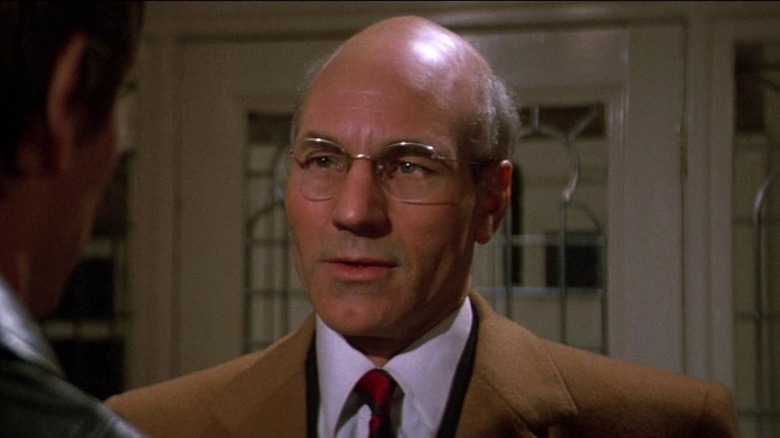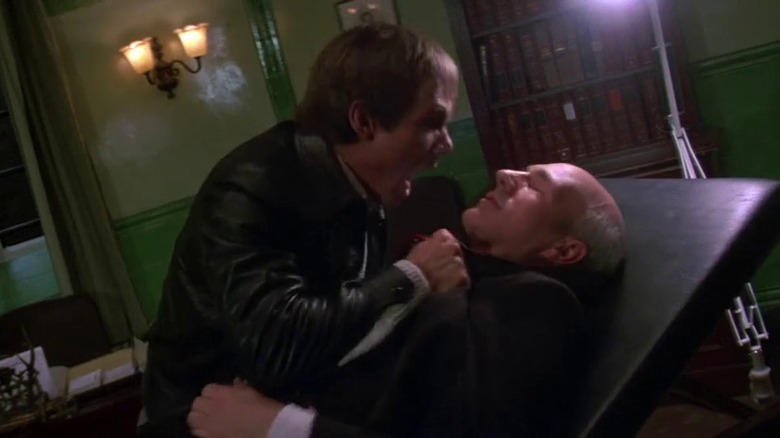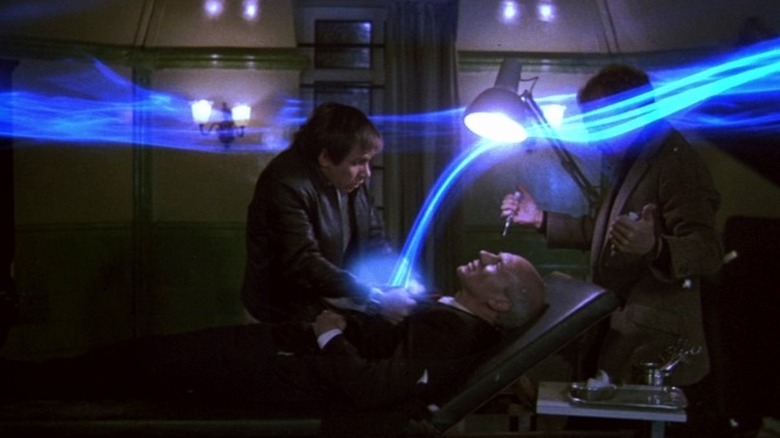Tobe Hooper’s 1985 sci-fi vampire film “Lifeforce” is one of the stranger genre exercises of its era. It was produced by the Cannon Group, an exploitation movie house founded in Israel by B-movie luminaries Menahem Golan and Yoram Globus, so it comes with a schlocky imprimatur right out of the gate. “Lifeforce” also has plenty of traditionally schlocky elements, including space vampires, amazing monster effects (it has one of the best practical living corpses in film history), and extensive nudity. The first detail many may remember from “Lifeforce” is the vision of actor Mathilda May wandering around a space laboratory without a stitch of clothing.
The rules of the space vampires in “Lifeforce” aren’t entirely clear, as Texan director Hooper was more interested in a sense of dread than plot clarity. It seems that the space vampires can not only shape-shift, but also subsist by “drinking” lightning-light energy out of the faces of their victims. They’re also psychic and can take the form of anyone inside your mind. This is why the vampire chose to look like a nude Mathilda May; the vampire reached into the mind of Dr. Carlsen (Steve Railsback) and found the ultimate example of femininity.
Later in the film, the vampire takes possession of a character named Dr. Armstrong, who’s played by Patrick Stewart prior to his “Star Trek” fame. When Dr. Armstrong was injected with an eerie hypnotism drug, the vampire spirit inside him emerged. The vampire wanted to lure Carlsen closer and closer and “kiss” the lifeforce out of his body. Hooper, however, decided to depict Carlsen drifting closer and closer to kissing a seductive Patrick Stewart. When the vampire finally got her mouth on Carlsen, it was between Railsback and Stewart. As surprising as it may seem, this was Stewart’s first-ever on-screen kiss.
Patrick Stewart’s Hollywood screen kiss
The presence of Stewart contributed to the odd tone of “Lifeforce,” as it was seemingly being presented as an old-world production from England’s Hammer Studios. “Lifeforce” also included other British veterans like Peter Firth, Aubrey Morris, and Frank Finlay, giving the film a unique vibe specific to British horror. The film, however, spins pretty wildly out of control by the end, which was the wont of the late great Tobe Hooper. There is a lot of screaming, indoor lightning, and lifeforce suckage.
According to the special features on the “Lifeforce” Blu-ray, Stewart had, even by 1985, never had an on-screen kiss before. He had kissed others on stage, no doubt, but his film and TV career tended to keep him away from snogging. He might not have been able to predict that Steve Railsback would be his first smooch, much less while he was playing a man possessed by a young female vampire monster.
Stewart, of course, had already been acting for decades by the time he made “Lifeforce,” having begun on stage back in 1959 when he was only 19 years old. He first appeared on TV in 1967, playing a random firefighter in an episode of the long-running soap opera “Coronation Street,” and made his theatrical film debut in the 1975 film “Hedda.” He was known for his work with the Royal Shakespeare Company and played Claudius in the 1980 BBC version of “Hamlet.” In terms of big-scale Hollywood productions, Stewart had appeared in films like “Excalibur” and David Lynch’s “Dune” (playing Gurney Halleck).
Despite dozens and dozens of roles, though, Stewart was rarely cast as a romantic lead, and wasn’t often paired with lovers. Kissing just wasn’t something he was asked to do very often. Railsback rectified that.
Lifeforce is only part of Railsback’s fascinating career
American actor Railsback, meanwhile, also has a storied career, albeit with more time in feature films than Stewart. Railsback began acting professionally in the 1972 Elia Kazan drama “The Visitors,” and has acted in some great — and some not-so-great — films ever since. He played Charles Manson in the 1976 film version of “Helter Skelter” and was in the excellent “The Stunt Man” in 1980. In 1987, he starred in “Nukie,” one of the most notoriously bad movies of all time. He also appeared on TV shows like “The Twilight Zone,” “The X-Files,” and “The Practice.” Railsback has never been hurting for work. He seems to have retired in 2018.
“Lifeforce,” for Railsback, was another monster movie on his resume. For Stewart, it was a rare big studio gig. It wouldn’t be until 1987 that Stewart would appear on “Star Trek: The Next Generation” and experience a surge of fame his career hadn’t previously known. Stewart was a very serious actor, however, and one can see that he took his role as Dr. Armstrong very seriously. He was also devoted to playing a young woman, and likely had no qualms smooching a sweaty, screaming co-star.
Stewart wouldn’t play a queer character on screen until 1994 with the release of the indie comedy “Jeffrey.” Stewart said the experience was liberating. It’s astonishing to think that a well-regarded actor like Stewart wouldn’t have any on-screen kisses for so long. Since “Lifeforce,” however, he’s had several opportunities to suck face.










